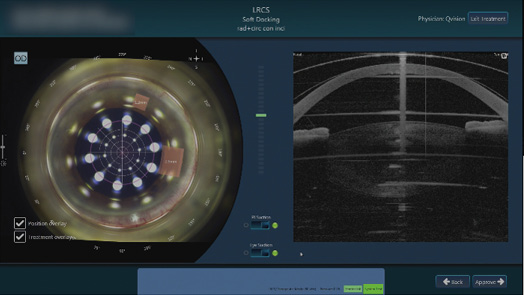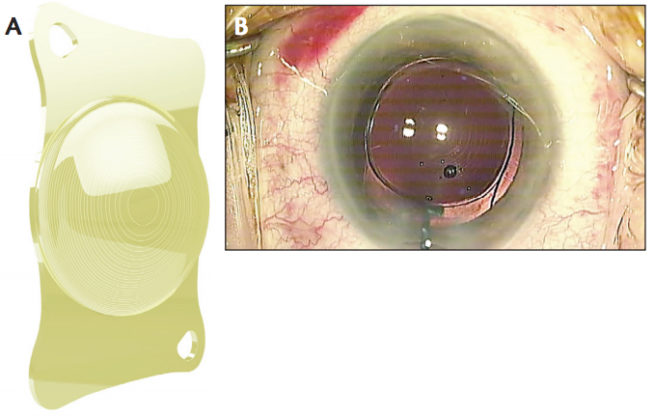
For the past several years, I have been perfecting what I consider to be the complete refractive cataract surgery package that I can offer to my patients. Over this time, I have tried many different IOLs and many various technologies, all in effort to provide patients with safe, individualized care and the best possible refractive outcomes. My conclusion to date is that three integral parts to this equation include the Victus femtosecond laser (Technolas Perfect Vision, a Bausch + Lomb Company), the Stellaris Vision Enhancement System (Bausch + Lomb), and the Versario Multifocal 3F IOL (Bausch + Lomb).
INDIVIDUALIZED CARE
I firmly believe that one of the basic principles of refractive cataract surgery is being able to individualize patient care. Therefore, one reason that I trust the care of my patients to the Victus is that it allows me to customize the configuration of the capsulotomy and the pattern of the lens fragmentation based on the patient’s cataract grade. Even the construction of the arcuate and corneal incisions can be individualized to the patient’s ocular anatomy.
In addition to the customizability of the Victus, safety is another reason that I prefer laser-assisted cataract surgery (LACS) to manual cataract surgery. For example, with LACS, I have seen the rate of capsule-related complications virtually disappear. One important element to the success of the capsulotomy created by the laser is docking the patient’s eye to the laser. By not using too much pressure, I can avoid endothelial folds, which would defocus the laser beam, and ensure a 100% free-floating capsulotomy.
WHY VICTUS?
The most valuable feature of the Victus—and something that is unique to the platform—is the incorporation of swept-source OCT. This feature is important not only in cataract surgery, but also in therapeutic and corneal procedures as well. As seen in a screen shot of the Victus software (Figure 1), the real-time surgery image is located on the left, the swept-source OCT image on the right, and the pressure gradient in the center. This screen is available during capsulotomy, lens fragmentation, and incision creation as well as during LASIK flap creation and all therapeutic procedures, such as penetrating and lamellar keratoplasties.

Figure 1. With the Victus, the real-time surgery image is on the left, the swept-source OCT image on the right, and the pressure gradient in the center.
When using the Victus to fragment the nucleus of a grade 2 cataract, I prefer to select a four radial, four circular pattern. For anything higher than a grade 2 cataract, I prefer a reticular pattern because it is easier to extract the nucleus with ultrasound.
Once the capsulotomy and fragmentation is achieved in a soft-docking mode, the eye is docked and the incisions are created. In my hands and with my instrumentation, I prefer a 2.5-mm main incision and a 1.2-mm paracentesis. After the femtosecond laser part of surgery is complete, the patient is moved to a separate operating room in which phacoemulsification and IOL implantation are performed.
PHACOEMULSIFICATION
For phacoemulsification, I prefer the Stellaris because it gives me the opportunity to perform microincision cataract surgery. As a result of the excellent anterior chamber stability, I can comfortably decrease my incision size without sacrificing the safety of the procedure. More features of the recently enhanced Stellaris can be found in the accompanying sidebar.
For the past 2 years, I have performed all of my surgeries with the 30º Zero Phaco I/A handpiece (Bausch + Lomb Storz Ophthalmic Instruments). This sterile, single-use handpiece is an important tool in order to prevent toxic anterior segment syndrome. The silicone irrigation sleeve increases wound sealability and works perfectly with the Stellaris platform.
Once inside the anterior chamber, in order to avoid opacification, it is important to rotate the nucleus and then perform a soft but decisive resection. I aspirate the cataract, beginning in the periphery with the epinucleus, in order to remove the softer material first, and travelling to the center of the nucleus.
IOL SELECTION
Two of the newest IOL categories are trifocal and extended depth of focus (EDOF) lenses. On one hand, trifocal IOLs probably provide the best near vision, but there is the chance for dysphotopsias. On the other hand, EDOF lenses reduce the incidence of dysphotopsias, but they do not provide the same level of near vision as trifocal IOLs. Alternatively, the Versario Multifocal 3F (Figure 2), in my opinion, provides the best of both worlds because the near and intermediate additions are placed at the spectacle plane, at around 45 cm (2.20 D) and at 90 cm (1.11 D), respectively.
This lens is a patient-friendly, universal platform, and, in my experience, patients have been extremely happy with their results. I have noticed that this lens is the best option for patients who are heavy users of mobile devices, tablets, and computers.

Figure 2. The Versario Multifocal 3F design (A) and the lens in situ (B).
CONCLUSION
Refractive cataract surgery is not a science, but it does require that surgeons pay special attention to offering patients individualized care. I believe that LACS with the Victus, phacoemulsification with the Stellaris, and IOL implantation with the Versario Multifocal 3F are key components of the process. I feel comfortable offering patients this complete refractive cataract surgery package, as I am confident they will achieve excellent postoperative outcomes.
Continuing Innovation: Stellaris Activate
Stellaris Activate, the next generation of phaco surgical systems, is designed to accommodate a surgeon’s needs and surgical technique and to optimize chamber stability and control. Whether performing standard or microincision cataract surgery (MICS) procedures or as part of the femtosecond laser cataract procedure, Stellaris Activate provides the performance when needed. The latest updates on the Stellaris system include:
- New footpedal design and screen;
- DigiFlow Infusion Control;
- Common surgeon files transportable from Stellaris to Stellaris PC;
- Enhanced on-screen user controls and drop-down menus; and
- Enhanced messaging features for clarity and ease of use.
Stellaris Activate provides vacuum-based StableChamber fluidics with the option of DigiFlow pressurized infusion settings, with 76% of surgeons who have used the technology experiencing improved chamber stability compared with gravity feed.1 Other components aimed at optimizing the chamber stability include the VFM StableChamber Tubing, designed to control and stabilize flow in MICS High Vacuum procedures; advanced hardware; and customizable software settings.
Furthermore, the Stellaris Active features an innovative wireless programmable footpedal with Dual Linear technology control for modulating several parameters with one footpedal.
1. Data on file with Bausch + Lomb.

